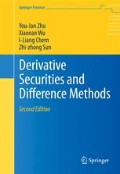Abstract
As pointed out in Sect. 2.3, when the short-term interest rate is considered as a random variable, there is an unknown function λ(r, t), called the market price of risk, in the governing equation.
Access this chapter
Tax calculation will be finalised at checkout
Purchases are for personal use only
Notes
- 1.
This is because w 2(r, t) ≥ 0 on \([r_{l},r_{u}]\).
- 2.
Or assume \(\lambda (r,t) =\bar{\lambda } (t) + u(r,t)/w(r,t)\), which is equivalent to let u(r, t) = 0 and \(\lambda (r,t) =\bar{\lambda } (t)\).
- 3.
There we assume \(\lambda (r,t) =\bar{\lambda } (t) + u(r,t)/w(r,t)\). However the procedures of determining \(\bar{\lambda }(t)\) and λ(t) from the zero-coupon bond price curve are the same.
- 4.
As the first guess, we can let \({\lambda }^{1/2} =\lambda (0)\) and \({\lambda }^{n+1/2} {=\lambda }^{n-1/2}\) for n≠0.
- 5.
When these values of caps were computed, a cap was defined as a sum of 4N caplets. For those results on floors, the situation is similar.
- 6.
In this way, for any day in the period from January 4, 1982, to February 15, 2002, we can obtain the theoretical values of \(S_{2},S_{3},\) and S 5 by giving the market data of \(S_{1},S_{4},\) and S 6. That is, from the market prices of 3-month, 2-year, and 5-year zero-coupon bonds we can obtain the theoretical prices of 6-month, 1-year, and 3-year zero-coupon bonds for any day. In Fig. 10.7 we compare the theoretical prices of 6-month, 1-year, and 3-year zero-coupon bonds with their market data for any day in the period from January 4, 1982, to February 15, 2002. The figure shows that the theoretical prices and the market data are very close to each other.
References
Zhang, G.-Q, Li, P.-J.: An inverse problem of derivative security pricing. In: Hon, Y.-C., Yamamoto, M., Cheng, J., Lee, J.-Y. (eds.) Recent Development in Theory and Numerics. International Conference on Inverse Problems, pp. 411–419. World Scientific, Singapore (2003)
Zhu, Y.-l., Yang, C.: Pricing American swaptions by using three-factor interest rate models. Working Paper, University of North Carolina at Charlotte, Charlotte (2004)
Author information
Authors and Affiliations
Rights and permissions
Copyright information
© 2013 Springer Science+Business Media New York
About this chapter
Cite this chapter
Zhu, Yl., Wu, X., Chern, IL., Sun, Zz. (2013). Interest Rate Modeling. In: Derivative Securities and Difference Methods. Springer Finance. Springer, New York, NY. https://doi.org/10.1007/978-1-4614-7306-0_10
Download citation
DOI: https://doi.org/10.1007/978-1-4614-7306-0_10
Published:
Publisher Name: Springer, New York, NY
Print ISBN: 978-1-4614-7305-3
Online ISBN: 978-1-4614-7306-0
eBook Packages: Mathematics and StatisticsMathematics and Statistics (R0)

